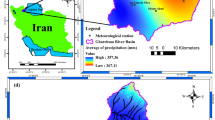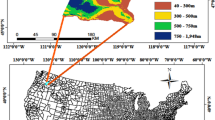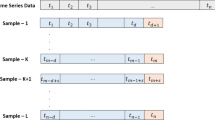Abstract
Prediction of atmospheric air temperature (AAT) time series is an important issue as it gives information to society and sustainability for future planning. In this study, a deep learning method, namely, long short-term memory (LSTM) network, based on one-step-ahead prediction approach was proposed to predict AAT using the actual time series data. For the proposed prediction method, a set of measurement data in 10-min, hourly, and daily intervals obtained from Mersin and Belen stations located in the Eastern Mediterranean Region of Turkey was used. Mean absolute percentage error (MAPE), root mean square error (RMSE), correlation coefficient (R), mean absolute error (MAE), and average bias were considered as evaluation criteria. According to the testing process, the RMSE, MAPE, MAE, R, and bias values for the 10-min interval AAT prediction were calculated as 0.35 °C, 1.40%, 0.25 °C, 0.995, and 0.074 °C, respectively. Considering the prediction results of the hourly AAT predication, the above statistical metrics with the same order were obtained as 0.61 °C, 1.85%, 0.43 °C, 0.945, and −0.013 °C. Concerning the daily AAT prediction results with LSTM, the above statistical metrics with the same order were computed as 1.33 °C, 3.27%, 0.99 °C, 0.97, and −0.116 °C. Compared to the hourly and daily AAT predictions, LSTM provided better accuracy results in predicting 10-min interval AAT. The prediction results from the three different time series data show that the prediction of AATs using LSTM can provide high accuracy results for short-term prediction using data with a long period time. On the other hand, adaptive neuro-fuzzy inference system with fuzzy C-means (ANFIS-FCM) method and autoregressive moving average (ARMA) model were also used to compare the results of LSTM method. Both LSTM and ANFIS-FCM network model showed high accuracy for the prediction of 10-min interval, hourly, and daily AAT data with RMSE values between 0.31 and 1.52 °C, while ARMA model failed to provide high accuracies for all predictions.








Similar content being viewed by others
References
Abdulshahed AM, Longstaff AP, Fletcher S (2015) The application of ANFIS prediction models for thermal error compensation on CNC machine tools. Appl Soft Comput 27:158–168. https://doi.org/10.1016/j.asoc.2014.11.012
Akbari S, Mahmood SM, Tan IM, Hematpour H (2018) Comparison of neuro-fuzzy network and response surface methodology pertaining to the viscosity of polymer solutions. J Pet Explor Prod Technol 8:887–900. https://doi.org/10.1007/s13202-017-0375-6
Al-Hmouz A, Shen J, Al-Hmouz R, Yan J (2012) Modeling and simulation of an adaptive neuro-fuzzy inference system (ANFIS) for mobile learning. IEEE Trans Learn Technol 5:226–237. https://doi.org/10.1109/TLT.2011.36
Arslan N, Sekertekin A (2019) Application of long short-term memory neural network model for the reconstruction of MODIS land surface temperature images. J Atmos Solar-Terrestrial Phys 105100:105100. https://doi.org/10.1016/j.jastp.2019.105100
Azad A, Kashi H, Farzin S, Singh VP, Kisi O, Karami H, Sanikhani H (2020) Novel approaches for air temperature prediction: a comparison of four hybrid evolutionary fuzzy models. Meteorol Appl 27. https://doi.org/10.1002/met.1817
Balluff S, Bendfeld J, Krauter S (2015) Short term wind and energy prediction for offshore wind farms using neural networks. In: 2015 International Conference on Renewable Energy Research and Applications (ICRERA). IEEE, Palermo, pp 379–382. https://doi.org/10.1109/icrera.2015.7418440
Benbahria Z, Sebari İ, Hajji H, Smiej MF (2021) Intelligent mapping of irrigated areas from Landsat 8 images using transfer learning. Int J Eng Geosci. https://doi.org/10.26833/ijeg.681312
Bezdek JC (1981) Pattern recognition with fuzzy objective function algorithms. Springer US, Boston, MA
Bilgili M, Sahin B (2009) Prediction of long-term monthly temperature and rainfall in Turkey. Energy Sources, Part A Recover Util Environ Eff 32:60–71. https://doi.org/10.1080/15567030802467522
Box GEP, Jenkins GM (1976) Time series analysis: forecasting and control. Holden–Day, San Francisco
Box GEP, Meyer RD (1986) An analysis for unreplicated fractional factorials. Technometrics 28:11–18. https://doi.org/10.1080/00401706.1986.10488093
Chen J, Zeng G-Q, Zhou W, du W, Lu KD (2018) Wind speed forecasting using nonlinear-learning ensemble of deep learning time series prediction and extremal optimization. Energy Convers Manag 165:681–695. https://doi.org/10.1016/j.enconman.2018.03.098
Chen M-R, Zeng G-Q, Lu K-D, Weng J (2019a) A two-layer nonlinear combination method for short-term wind speed prediction based on ELM, ENN, and LSTM. IEEE Internet Things J 6:6997–7010. https://doi.org/10.1109/JIOT.2019.2913176
Chen Y, Zhang S, Zhang W, Peng J, Cai Y (2019b) Multifactor spatio-temporal correlation model based on a combination of convolutional neural network and long short-term memory neural network for wind speed forecasting. Energy Convers Manag 185:783–799. https://doi.org/10.1016/j.enconman.2019.02.018
Chevalier RF, Hoogenboom G, McClendon RW, Paz JA (2011) Support vector regression with reduced training sets for air temperature prediction: a comparison with artificial neural networks. Neural Comput Applic 20:151–159. https://doi.org/10.1007/s00521-010-0363-y
Cobaner M, Citakoglu H, Kisi O, Haktanir T (2014) Estimation of mean monthly air temperatures in Turkey. Comput Electron Agric 109:71–79. https://doi.org/10.1016/j.compag.2014.09.007
Dong D, Sheng Z, Yang T (2018) Wind power prediction based on recurrent neural network with long short-term memory units. In: 2018 International Conference on Renewable Energy and Power Engineering (REPE). IEEE, Toronto, pp 34–38. https://doi.org/10.1109/repe.2018.8657666
Fahimi Nezhad E, Fallah Ghalhari G, Bayatani F (2019) Forecasting maximum seasonal temperature using artificial neural networks “Tehran case study”. Asia-Pac J Atmos Sci 55:145–153. https://doi.org/10.1007/s13143-018-0051-x
Güldal V, Tongal H (2010) Comparison of recurrent neural network, adaptive neuro-fuzzy inference system and stochastic models in Eğirdir Lake level forecasting. Water Resour Manag 24:105–128. https://doi.org/10.1007/s11269-009-9439-9
Han S, Qiao Y, Yan J, Liu YQ, Li L, Wang Z (2019) Mid-to-long term wind and photovoltaic power generation prediction based on copula function and long short term memory network. Appl Energy 239:181–191. https://doi.org/10.1016/j.apenergy.2019.01.193
Hochreiter S, Schmidhuber J (1997) Long short-term memory. Neural Comput 9:1735–1780. https://doi.org/10.1162/neco.1997.9.8.1735
Hu Y-L, Chen L (2018) A nonlinear hybrid wind speed forecasting model using LSTM network, hysteretic ELM and Differential Evolution algorithm. Energy Convers Manag 173:123–142. https://doi.org/10.1016/j.enconman.2018.07.070
Huang Y, Liu S, Yang L (2018) Wind speed forecasting method using EEMD and the combination forecasting method based on GPR and LSTM. Sustainability 10:3693. https://doi.org/10.3390/su10103693
Jang JR (1993) ANFIS: adaptive network-based fuzzy inference system. IEEE Trans Syst Man Cybern Syst 23:665–685. https://doi.org/10.1109/21.256541
Kalogirou SA (2001) Artificial neural networks in renewable energy systems applications: a review. Renew Sust Energ Rev 5:373–401. https://doi.org/10.1016/S1364-0321(01)00006-5
Karahoca A, Karahoca D (2011) GSM churn management by using fuzzy c-means clustering and adaptive neuro fuzzy inference system. Expert Syst Appl 38:1814–1822. https://doi.org/10.1016/j.eswa.2010.07.110
Karakuş O, Kuruoǧlu EE, Altinkaya MA (2017) One-day ahead wind speed/power prediction based on polynomial autoregressive model. IET Renew Power Gener 11:1430–1439. https://doi.org/10.1049/iet-rpg.2016.0972
Kim HS, Park I, Song CH, Lee K, Yun JW, Kim HK, Jeon M, Lee J, Han KM (2019) Development of a daily PM 10 and PM 2.5 prediction system using a deep long short-term memory neural network model. Atmos Chem Phys 19:12935–12951. https://doi.org/10.5194/acp-19-12935-2019
Kisi O, Sanikhani H (2015) Modelling long-term monthly temperatures by several data-driven methods using geographical inputs. Int J Climatol 35:3834–3846. https://doi.org/10.1002/joc.4249
Kisi O, Shiri J (2014) Prediction of long-term monthly air temperature using geographical inputs. Int J Climatol 34:179–186. https://doi.org/10.1002/joc.3676
Krishan M, Jha S, Das J, Singh A, Goyal MK, Sekar C (2019) Air quality modelling using long short-term memory (LSTM) over NCT-Delhi, India. Air Qual Atmos Health 12:899–908. https://doi.org/10.1007/s11869-019-00696-7
Lai Y, Dzombak DA (2020) Use of the autoregressive integrated moving average (ARIMA) model to forecast near-term regional temperature and precipitation. Weather Forecast 35:959–976. https://doi.org/10.1175/WAF-D-19-0158.1
Li X, Peng L, Yao X, Cui S, Hu Y, You C, Chi T (2017) Long short-term memory neural network for air pollutant concentration predictions: method development and evaluation. Environ Pollut 231:997–1004. https://doi.org/10.1016/j.envpol.2017.08.114
Li Z, Tang T, Gao C (2019) Long short-term memory neural network applied to train dynamic model and speed prediction. Algorithms 12:173. https://doi.org/10.3390/a12080173
Liang S, Nguyen L, Jin F (2018) A multi-variable stacked long-short term memory network for wind speed forecasting. In: 2018 IEEE International Conference on Big Data (Big Data). IEEE, Seattle, pp 4561–4564. https://doi.org/10.1109/BigData.2018.8622332
Liu H, Mi X, Li Y (2018a) Wind speed forecasting method based on deep learning strategy using empirical wavelet transform, long short term memory neural network and Elman neural network. Energy Convers Manag 156:498–514. https://doi.org/10.1016/j.enconman.2017.11.053
Liu H, Mi X, Li Y (2018b) Smart multi-step deep learning model for wind speed forecasting based on variational mode decomposition, singular spectrum analysis, LSTM network and ELM. Energy Convers Manag 159:54–64. https://doi.org/10.1016/j.enconman.2018.01.010
Loganathan N, Ibrahim Y (2010) Forecasting international tourism demand in Malaysia using Box Jenkins Sarima application. South Asian J Tour Herit 3:50–60
López E, Valle C, Allende H, Gil E, Madsen H (2018) Wind power forecasting based on echo state networks and long short-term memory. Energies 11:526. https://doi.org/10.3390/en11030526
Ma X, Tao Z, Wang Y, Yu H, Wang Y (2015) Long short-term memory neural network for traffic speed prediction using remote microwave sensor data. Transp Res Part C Emerg Technol 54:187–197. https://doi.org/10.1016/j.trc.2015.03.014
Massaoudi M, Chihi I, Sidhom L et al (2021) An effective hybrid NARX-LSTM model for point and interval PV power forecasting. IEEE Access 9:36571–36588. https://doi.org/10.1109/ACCESS.2021.3062776
Mathworks (2019) Long short-term memory networks. https://www.mathworks.com/help/deeplearning/ug/long-short-term-memory-networks.html. Accessed 22 Jul 2019
Meshram SG, Kahya E, Meshram C, Ghorbani MA, Ambade B, Mirabbasi R (2020) Long-term temperature trend analysis associated with agriculture crops. Theor Appl Climatol 140:1139–1159. https://doi.org/10.1007/s00704-020-03137-z
Muzaffar S, Afshari A (2019) Short-term load forecasts using LSTM networks. Energy Procedia 158:2922–2927. https://doi.org/10.1016/j.egypro.2019.01.952
Nash JE, Sutcliffe JV (1970) River flow forecasting through conceptual models part I — a discussion of principles. J Hydrol 10:282–290. https://doi.org/10.1016/0022-1694(70)90255-6
Pak U, Kim C, Ryu U, Sok K, Pak S (2018) A hybrid model based on convolutional neural networks and long short-term memory for ozone concentration prediction. Air Qual Atmos Health 11:883–895. https://doi.org/10.1007/s11869-018-0585-1
Park K, Lee et al (2019) Temperature prediction using the missing data refinement model based on a long short-term memory neural network. Atmosphere (Basel) 10:718. https://doi.org/10.3390/atmos10110718
Peng L, Liu S, Liu R, Wang L (2018) Effective long short-term memory with differential evolution algorithm for electricity price prediction. Energy 162:1301–1314. https://doi.org/10.1016/j.energy.2018.05.052
Qi Y, Zhou Z, Yang L, Quan Y, Miao Q (2019) A decomposition-ensemble learning model based on LSTM neural network for daily reservoir inflow forecasting. Water Resour Manag 33:4123–4139. https://doi.org/10.1007/s11269-019-02345-1
Qin Y, Li K, Liang Z, Lee B, Zhang F, Gu Y, Zhang L, Wu F, Rodriguez D (2019) Hybrid forecasting model based on long short term memory network and deep learning neural network for wind signal. Appl Energy 236:262–272. https://doi.org/10.1016/j.apenergy.2018.11.063
Qing X, Niu Y (2018) Hourly day-ahead solar irradiance prediction using weather forecasts by LSTM. Energy 148:461–468. https://doi.org/10.1016/j.energy.2018.01.177
Qu X, Xiaoning K, Chao Z et al (2016) Short-term prediction of wind power based on deep long short-term memory. In: 2016 IEEE PES Asia-Pacific Power and Energy Engineering Conference (APPEEC). IEEE, pp 1148–1152
Radhika Y, Shashi M (2009) Atmospheric temperature prediction using support vector machines. Int J Comput Theory Eng:55–58. https://doi.org/10.7763/IJCTE.2009.V1.9
Rajagopalan S, Santoso S (2009) Wind power forecasting and error analysis using the autoregressive moving average modeling. In: 2009 IEEE Power & Energy Society General Meeting. IEEE, Calgary, pp 1–6. https://doi.org/10.1109/PES.2009.5276019
Ramesh K, Anitha R (2014) MARSpline model for lead seven-day maximum and minimum air temperature prediction in Chennai, India. J Earth Syst Sci 123:665–672. https://doi.org/10.1007/s12040-014-0434-z
Rezaie B, Nikoo SY, Rahmani Z (2018) A novel intelligent fast terminal sliding mode control for a class of nonlinear systems: application to atomic force microscope. Int J Dyn Control 6:1335–1350. https://doi.org/10.1007/s40435-017-0376-9
Salman AG, Heryadi Y, Abdurahman E, Suparta W (2018) Single layer & multi-layer long short-term memory (LSTM) model with intermediate variables for weather forecasting. Procedia Comput Sci 135:89–98. https://doi.org/10.1016/j.procs.2018.08.153
Sariturk B, Bayram B, Duran Z, Seker DZ (2020) Feature extraction from satellite images using segnet and fully convolutional networks (FCN). Int J Eng Geosci. https://doi.org/10.26833/ijeg.645426
Sekula P, Bokwa A, Bochenek B, Zimnoch M (2019) Prediction of air temperature in the Polish Western Carpathian mountains with the ALADIN-HIRLAM numerical weather prediction system. Atmosphere (Basel) 10:186. https://doi.org/10.3390/atmos10040186
Shafaei M, Kisi O (2016) Lake level forecasting using wavelet-SVR, wavelet-ANFIS and wavelet-ARMA conjunction models. Water Resour Manag 30:79–97. https://doi.org/10.1007/s11269-015-1147-z
Shi X, Lei X, Huang Q, Huang S, Ren K, Hu Y (2018) Hourly day-ahead wind power prediction using the hybrid model of variational model decomposition and long short-term memory. Energies 11:3227. https://doi.org/10.3390/en11113227
Tabari H, Kisi O, Ezani A, Hosseinzadeh Talaee P (2012) SVM, ANFIS, regression and climate based models for reference evapotranspiration modeling using limited climatic data in a semi-arid highland environment. J Hydrol 444–445:78–89. https://doi.org/10.1016/j.jhydrol.2012.04.007
Tian Y, Pan L (2015) Predicting short-term traffic flow by long short-term memory recurrent neural network. In: 2015 IEEE International Conference on Smart City/SocialCom/SustainCom (SmartCity). IEEE, pp 153–158
Tong W, Li L, Zhou X, Hamilton A, Zhang K (2019) Deep learning PM2.5 concentrations with bidirectional LSTM RNN. Air Qual Atmos Health 12:411–423. https://doi.org/10.1007/s11869-018-0647-4
Venkadesh S, Hoogenboom G, Potter W, McClendon R (2013) A genetic algorithm to refine input data selection for air temperature prediction using artificial neural networks. Appl Soft Comput 13:2253–2260. https://doi.org/10.1016/j.asoc.2013.02.003
Wang J, Li Y (2018) Multi-step ahead wind speed prediction based on optimal feature extraction, long short term memory neural network and error correction strategy. Appl Energy 230:429–443. https://doi.org/10.1016/j.apenergy.2018.08.114
Wu W, Chen K, Qiao Y, Lu Z (2016) Probabilistic short-term wind power forecasting based on deep neural networks. In: 2016 International Conference on Probabilistic Methods Applied to Power Systems (PMAPS). IEEE, Beijing, pp 1–8. https://doi.org/10.1109/PMAPS.2016.7764155
Xu Y, Liu H, Duan Z (2020) A novel hybrid model for multi-step daily AQI forecasting driven by air pollution big data. Air Qual Atmos Health 13:197–207. https://doi.org/10.1007/s11869-020-00795-w
Yu C, Li Y, Bao Y, Tang H, Zhai G (2018) A novel framework for wind speed prediction based on recurrent neural networks and support vector machine. Energy Convers Manag 178:137–145. https://doi.org/10.1016/j.enconman.2018.10.008
Yuan X, Chen C, Jiang M, Yuan Y (2019) Prediction interval of wind power using parameter optimized Beta distribution based LSTM model. Appl Soft Comput 82:105550. https://doi.org/10.1016/j.asoc.2019.105550
Zahroh S, Hidayat Y, Pontoh RS (2019) Modeling and forecasting daily temperature in Bandung. In: Proceedings of the International Conference on Industrial Engineering and Operations Management, Riyadh, Saudi Arabia, pp 406–412
Zaytar MA, El Amrani C (2016) Sequence to sequence weather forecasting with long short-term memory recurrent neural networks. Int J Comput Appl 143:7–11. https://doi.org/10.5120/ijca2016910497
Zhang Z, Moore JC (2015) Autoregressive moving average models. In: Mathematical and physical fundamentals of climate change. Elsevier Inc., Amsterdam, pp 239–290
Zhang X, Tan S-C, Li G (2014) Development of an ambient air temperature prediction model. Energy Build 73:166–170. https://doi.org/10.1016/j.enbuild.2014.01.006
Zhang Q, Wang H, Dong J, Zhong G, Sun X (2017) Prediction of sea surface temperature using long short-term memory. IEEE Geosci Remote Sens Lett 14:1745–1749. https://doi.org/10.1109/LGRS.2017.2733548
Zhang X, Zhang Q, Zhang G, Nie Z, Gui Z, Que H (2018) A novel hybrid data-driven model for daily land surface temperature forecasting using long short-term memory neural network based on ensemble empirical mode decomposition. Int J Environ Res Public Health 15:1032. https://doi.org/10.3390/ijerph15051032
Zhang J, Cao X, Xie J, Kou P (2019a) An improved long short-term memory model for dam displacement prediction. Math Probl Eng 2019:1–14. https://doi.org/10.1155/2019/6792189
Zhang J, Yan J, Infield D, Liu Y, Lien FS (2019b) Short-term forecasting and uncertainty analysis of wind turbine power based on long short-term memory network and Gaussian mixture model. Appl Energy 241:229–244. https://doi.org/10.1016/j.apenergy.2019.03.044
Zhang Z, Qin H, Liu Y, Wang Y, Yao L, Li Q, Li J, Pei S (2019c) Long short-term memory network based on neighborhood gates for processing complex causality in wind speed prediction. Energy Convers Manag 192:37–51. https://doi.org/10.1016/j.enconman.2019.04.006
Zhang Z, Ye L, Qin H, Liu Y, Wang C, Yu X, Yin X, Li J (2019d) Wind speed prediction method using shared weight long short-term memory network and Gaussian process regression. Appl Energy 247:270–284. https://doi.org/10.1016/j.apenergy.2019.04.047
Zhao J, Deng F, Cai Y, Chen J (2019) Long short-term memory - fully connected (LSTM-FC) neural network for PM2.5 concentration prediction. Chemosphere 220:486–492. https://doi.org/10.1016/j.chemosphere.2018.12.128
Zhou H, Zhang Y, Yang L, Liu Q, Yan K, du Y (2019a) Short-term photovoltaic power forecasting based on long short term memory neural network and attention mechanism. IEEE Access 7:78063–78074. https://doi.org/10.1109/ACCESS.2019.2923006
Zhou Y, Huang Y, Pang J, Wang K (2019b) Remaining useful life prediction for supercapacitor based on long short-term memory neural network. J Power Sources 440:227149. https://doi.org/10.1016/j.jpowsour.2019.227149
Author information
Authors and Affiliations
Corresponding author
Ethics declarations
Conflict of interest
The authors declare that they have no competing interests.
Additional information
Responsible Editor: Zhihua Zhang
Rights and permissions
About this article
Cite this article
Ozbek, A., Sekertekin, A., Bilgili, M. et al. Prediction of 10-min, hourly, and daily atmospheric air temperature: comparison of LSTM, ANFIS-FCM, and ARMA. Arab J Geosci 14, 622 (2021). https://doi.org/10.1007/s12517-021-06982-y
Received:
Accepted:
Published:
DOI: https://doi.org/10.1007/s12517-021-06982-y




